Home > Auctions > 26 November - 1 December 2024
Ancient Art, Antiquities, Natural History & Coins
Private collection formed in Europe in the 1980s.
Westminster collection, central London, UK.
Cf. Kershaw, J.F., Viking Identities. Scandinavian Jewellery in England, Oxford, 2013, pl.5, for type.
Private collection formed in Europe in the 1980s.
Westminster collection, central London, UK.
Acquired on the London art market, 1994.
Private collection, London.
Private collection formed in Europe in the 1980s.
Westminster collection, central London, UK.
Private collection, Koenigsberg, Germany.
Private collection, New York, USA.
with Artemis Gallery, 9 February 2021.
Private collection, London.
Cf. Arbman, H., Birka I: Die Gräber, Uppsala, 1940, pl. 100(2), 145, for type.
Acquired on the London art market, 1997.
Private collection, London.
From the John Hewitt collection (1919-1994).
Ex Sam Fogg, London, UK, dealer in the art of the Middle Ages.
Property of a Canadian collector living in Ontario; acquired 2018.
Supplied with a printed copy of Fornvännen article by Peter Pentz.
Cf. similar find from Oppelstrup, Denmark in Pentz, P., The same but Different. A note on a recently found zoomorphic drinking horn terminal, in Fornvännen, 2020/2, p.83.
Acquired on the London art market, 1993.
Private collection, London.
Cf. Franceschi, G., Jorn, A. & Magnus, B., Fuglen, Dyret og Mennesket i Nordisk Jernalderkunst, vol.2, Borgen, 2005, pls.21, 24, 25, 35, for type.
Found Stratton Strawless, Norfolk, UK.
From an old private collection of Norfolk, UK, gentleman, formed since 1998.
Accompanied by a copy of the British Museum's Portable Antiquities Scheme (PAS) report no.NMS-E92C94.
Cf. Roesdahl, E & Wilson, D., From Viking to Crusader. Scandinavia and Europe 800-1200, Uddevalla, 1992, item 588, for similar example.
The motif of the stag and the serpents is associated especially with Urnes Style objects.
Private collection, Koenigsberg, Germany.
Private collection, New York, USA.
with Artemis Gallery, 9 February 2021.
Private collection, London.
This lot has been checked against the Interpol Database of stolen works of art and is accompanied by a search certificate number no.12434-226853.
Cf. Arbman, H., Birka I: Die Gräber, Uppsala, 1940, pl.104.
Private collection formed in Europe in the 1980s.
Westminster collection, central London, UK.
Cf. Khrapunov, I. and Stylegar, F.A., Inter Ambo Maria, Contacts between Scandinavia and the Crimea in the Roman Period, Бажан И, А., Каргапольцев С, Ю, 1989, Об одной категории украшений-амулетов римского времени в Восточной Европе, СА, No.3; see. Meaney, A., Anglo-Saxon Amulets and Curing Stones, Oxford, BAR British Series 96, 1981, p.166-168, for discussion of the type.
Pendants in the form of miniature buckets have been found in a number of pagan Anglo-Saxon and Viking contexts and are generally made of bronze or iron, with gold examples being rare; three gold examples were found with the hoard from Hoen, Norway. Bronze bucket amulets have been found at Driffield in Yorkshire, and Vimose bog in Denmark, among other places. In form they represent wooden buckets bound with bronze or iron bands which have been found in Anglo-Saxon and Viking graves and are believed to have held mead or ale and were used to replenish the cups from which warriors drank. As amulets they probably represent the ecstatic power of alcoholic drink and the role of women as the dispensers of these precious beverages.
Private collection formed in Europe in the 1980s.
Westminster collection, central London, UK.
Cf. Korshyn, V.E., Yazicheskiye Priveski Drevniye Rusi X-XIV Vekov, Moscow, 2013, item J.2.02.
241 - 252 of 3419 LOTS

.jpg)
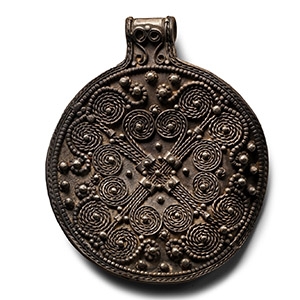
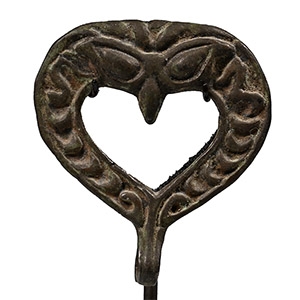


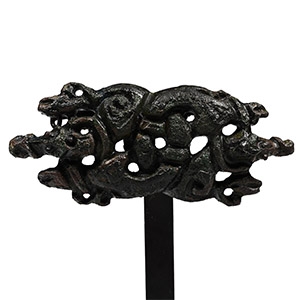
.jpg)
.jpg)
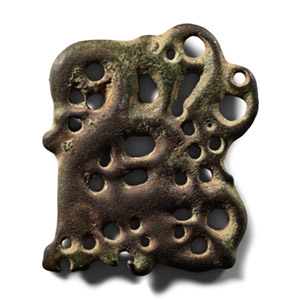
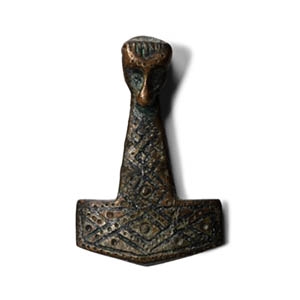
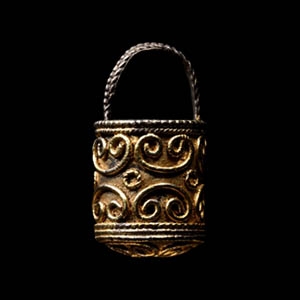
.jpg)



